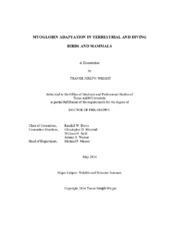| dc.contributor.advisor | Davis, Randall | |
| dc.creator | Wright, Traver J. | |
| dc.date.accessioned | 2015-01-09T20:52:21Z | |
| dc.date.available | 2016-05-01T05:31:00Z | |
| dc.date.created | 2014-05 | |
| dc.date.issued | 2014-04-25 | |
| dc.date.submitted | May 2014 | |
| dc.identifier.uri | https://hdl.handle.net/1969.1/152831 | |
| dc.description.abstract | Myoglobin (Mb) is an oxygen binding hemoprotein in vertebrate skeletal muscle
that functions in intracellular oxygen storage and transport. Due to the unique oxygen
storage demands of diving birds and mammals, these vertebrates can have Mb
concentrations ten-fold those found in their terrestrial counterparts making them ideal
animal models for studying Mb function. Increased Mb bound muscle oxygen stores
are advantageous for diving vertebrates, but Mb concentration optimized to maintain
aerobic metabolism while diving or limiting to aerobic dive duration? A numeric model
simulating a diving Weddell seal was created to examine physiological factors that
influence dive duration and optimal Mb concentration. Mb concentration was limiting to
dive duration in postabsorptive dives. However, Mb concentration was optimized for
postprandial dives which were limited by blood-bound oxygen stores due to the
additional metabolic costs of digestion.
While Mb concentration is adaptive in diving vertebrates, less is known about
molecular adaptation of Mb functional properties. Novel methods were developed to
extract Mb from frozen muscle and determine Mb oxygen affinity (P_(50)) by generating a
high resolution oxygen dissociation curve at 37°C. For comparison, Mb P_(50) was
determined for 25 species of diving and terrestrial birds and mammals. Myoglobin P_(50)
was conserved among terrestrial vertebrates and most cetaceans at approximately 3.7
mmHg with the exception of the melon-headed whale that had a significantly higher P_(50)
(lower oxygen affinity) of 4.85 mmHg. Among pinnipeds (seals and sea lions) the P_(50)
ranged from 3.23-3.81 mmHg and showed a trend for higher oxygen affinity in species
with longer dive durations. Among diving birds the P_(50) ranged from 2.40-3.36 mmHg
and also showed a trend of higher affinities in species with longer dive durations. Both
myoglobin concentration and oxygen affinity appear adaptive in diving vertebrates to
maintain aerobic metabolism and minimize hypoxic cellular damage in ischemic muscle. | en |
| dc.format.mimetype | application/pdf | |
| dc.language.iso | en | |
| dc.subject | myoglobin | en |
| dc.subject | oxygen affinity | en |
| dc.subject | marine mammal | en |
| dc.subject | diving | en |
| dc.subject | adaptation | en |
| dc.subject | evolution | en |
| dc.title | Myoglobin Adaptation in Terrestrial and Diving Birds and Mammals | en |
| dc.type | Thesis | en |
| thesis.degree.department | Wildlife and Fisheries Sciences | en |
| thesis.degree.discipline | Wildlife and Fisheries Sciences | en |
| thesis.degree.grantor | Texas A & M University | en |
| thesis.degree.name | Doctor of Philosophy | en |
| thesis.degree.level | Doctoral | en |
| dc.contributor.committeeMember | Marshall, Christopher | |
| dc.contributor.committeeMember | Neill, William | |
| dc.contributor.committeeMember | Wasser, Jeremy | |
| dc.type.material | text | en |
| dc.date.updated | 2015-01-09T20:52:21Z | |
| local.embargo.terms | 2016-05-01 | |


